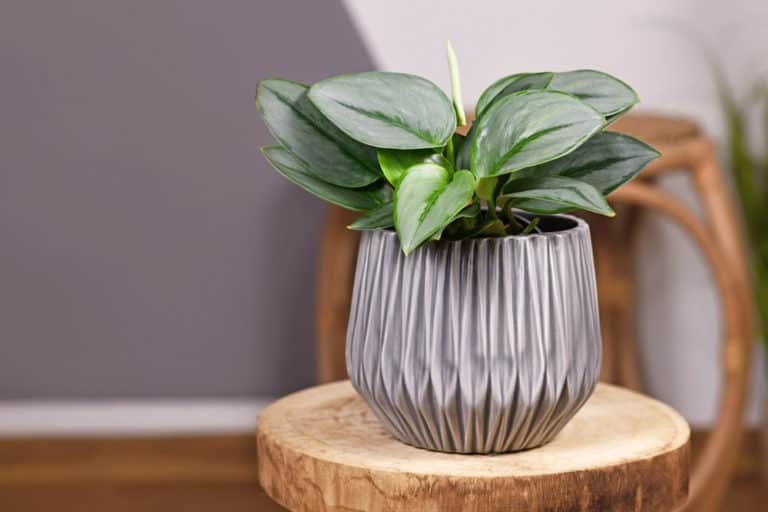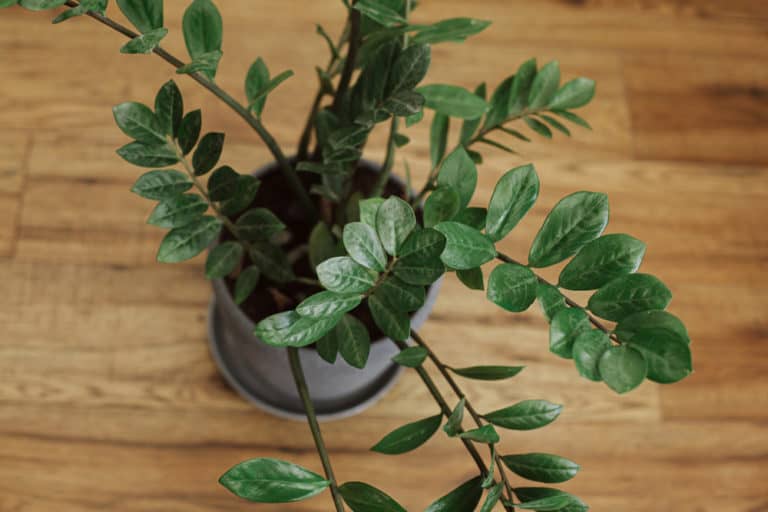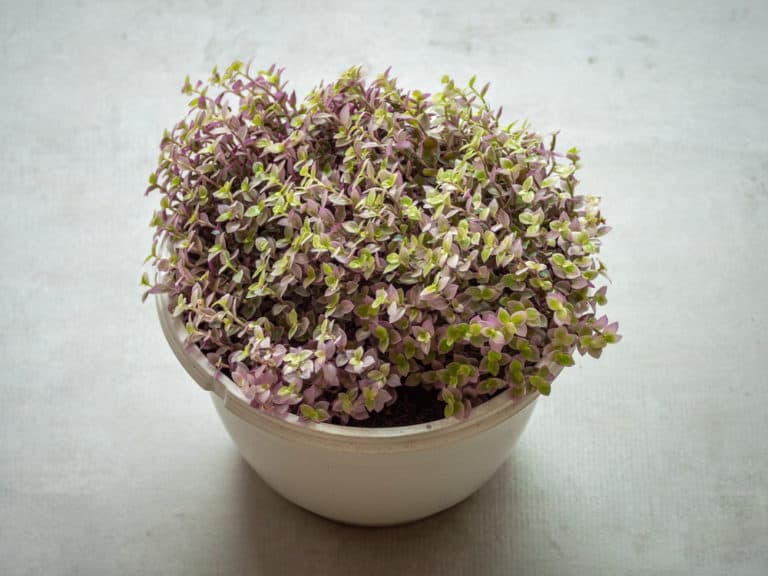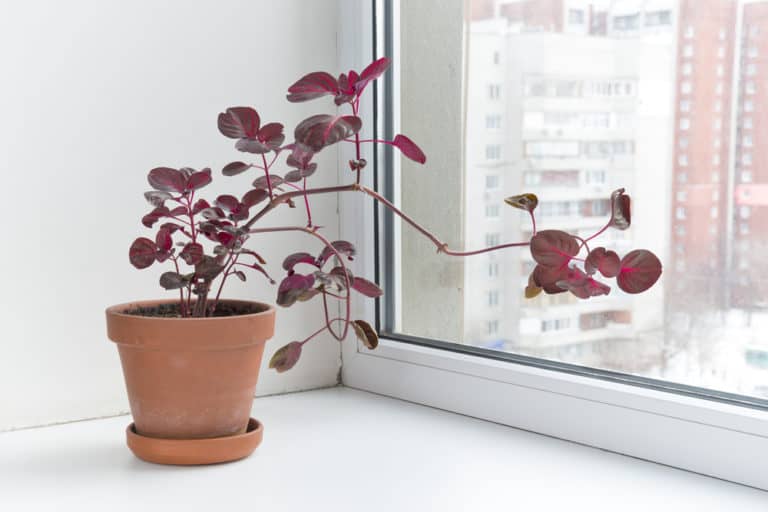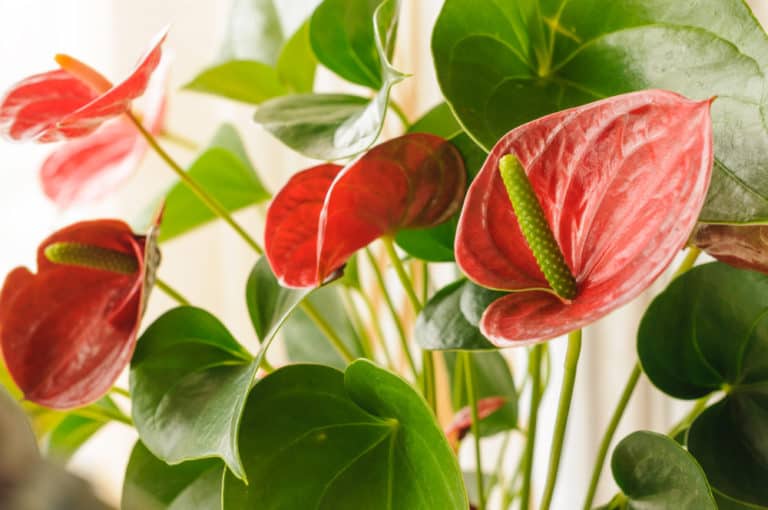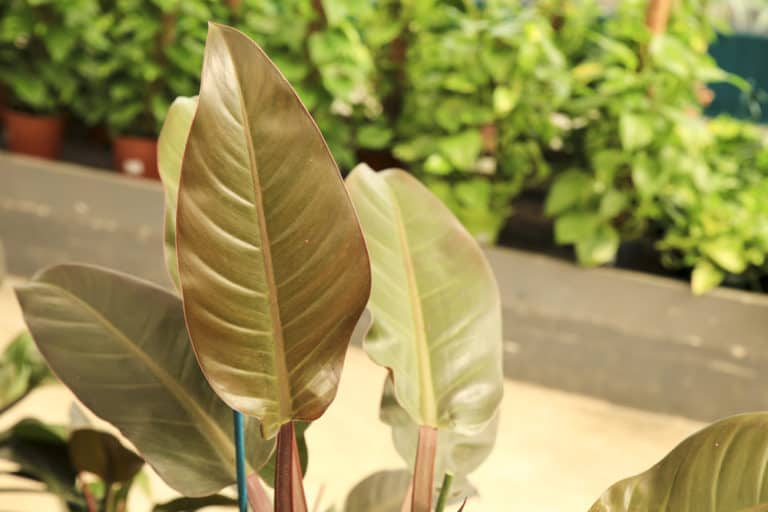Philodendron Hastatum ‘Silver Sword’ Care Guide (2024)
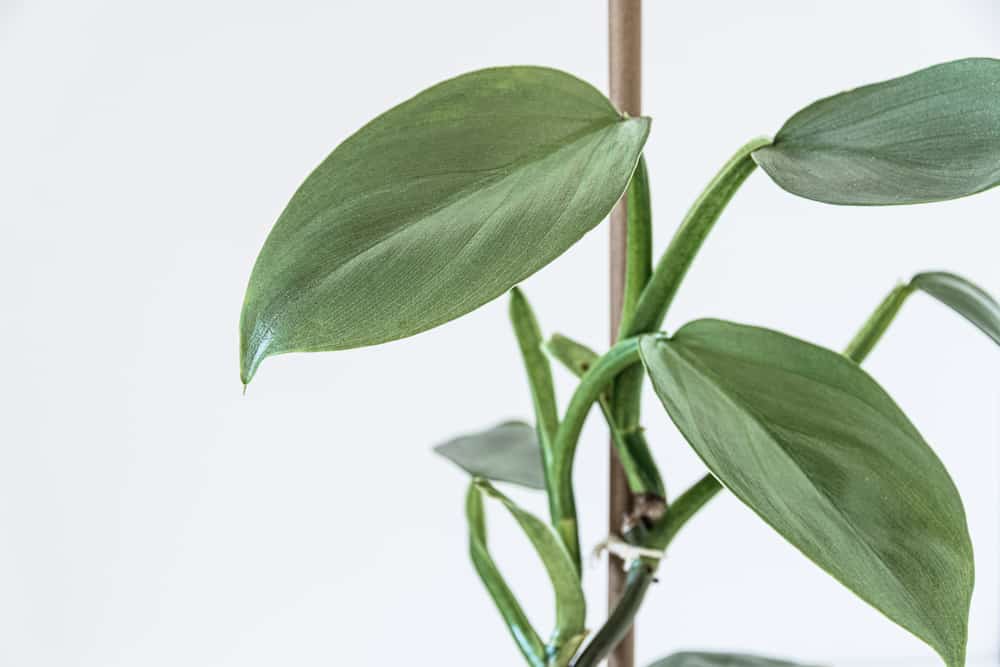
As a member of the Araceae family, the Silver sword Philodendron has its own reputation for dazzling broad leaves. But what’s unique with this plant is its silver sheen! Known botanically as Philodendron hastatum, the plant is a low-maintenance type, which is quite surprising when you consider how intimidating its looks can be.
| Scientific Name | Philodendron hastatum |
| Common Name | Silver Sword Philodendron, Hastatum Plant |
| Light | Bright indirect sunlight |
| Watering | Weekly, water if the top two inches of the soil already feel dry |
| Temperature | 65° and 80°F (18-27°C) |
| Hardiness Zone | USDA Hardiness zones 9b to 11 |
| Humidity | 50 to 75 % |
| Soil Type | Rich, quick-draining, high in OM |
| Soil pH | (6.1 – 7.5) mildly acidic to neutral |
| Fertilizing | A balanced feed during spring and summer |
| Repotting | A year or two |
| Pruning | Beginning of the growing season |
| Propagation | Stem Cuttings |
| Toxicity | Toxic to humans and pets |
| Mature Size | Can grow over 10 feet tall |
| Bloom Time | Rare, Spring and early summer |
What’s Unique About Silver Sword Philodendron?
The Silver Sword Philodendron plant features a gorgeous set of glossy leaves with a silver sheen, almost giving out a metallic look. It is considered a climbing vine, probably aided by its thick stems. Hence, it’s often raised with a trellis or a moss pole for support.
Silver Sword Philodendron plants are native to Brazil, specifically to the Minas Gerais and Rio de Janeiro. Sadly, most of these tropical and subtropical ornamental plants are disappearing due to massive deforestation. Thankfully, breeding efforts from various plant institutions are being conducted to preserve and develop all the best traits that come from the wild types of this plant.
Silver Sword Philodendron Care
The Silver Sword Philodendron plant care always starts with the use of a proper soil mix – rich in organic matter and amended with peat and perlite. In watering the plant, allow the top two inches of the soil to dry out before the next cycle. The ideal temperature also sits between 65° and 80°F.
Read further for more in-depth information regarding the Philodendron hastatum care!
Light
You may find it a relief that the Silver Sword Philodendron light requirements are not that critical. In fact, the plant would easily survive in a wide range of light conditions. However, you can expect robust growth and more vibrant foliage when the plant is grown under partially shaded areas that receive a sufficient amount of indirect sunlight.
Pro tip: When it comes to meeting Philodendron hastatum light needs, whether indoor or outdoor, it is important to choose a spot with adequate lighting. Avoid exposing the plant to full sun as this can damage the delicate foliages. Meanwhile, you should also observe if your plant is having a leggy stem or exhibiting signs of etiolation, as this could signal low light conditions.
Watering
Unlike most of its counterparts in the tropics, the Silver Sword Philodendron watering cycle is done more frequently. This is because the plant is considered a moisture-loving type. Hence, a little overwatering here and there wouldn’t hurt the plant.
Ideally, you should water Philodendron hastatum when the top two inches of the soil already feels dry to the touch. Watering needs of the plant may also vary with the current season, hence, you should adjust and increase watering in the summer and reduce it later on during winter and autumn. Always use a well-draining soil mix and a pot with sufficient drainage holes.
Temperature
In order to grow the plant optimally, you should be able to achieve and maintain the Silver Sword Philodendron temperature range which sits between 65° and 80°F (18-27°C). At night, the temperature for Philodendron hastatum should be around 60°F. Moreover, it is advised to bring the plant inside during winter as the plant does not possess an efficient low-temperature tolerance.
The Hastatum plant will thrive indoors and outdoors in regions covered by USDA hardiness zones 9b to 11. It is important to remember that a warmer condition will help the plant achieve ideal growth and excellent foliage development.
Humidity
Since the plant originates from the tropical rainforests of Brazil, it is fair to expect that the Silver Sword Philodendron humidity requirements are quite high. When growing the plant inside, be sure to maintain a humidity level of 50 to 75%.
If you seem to notice that your indoor setting has drier air, you may opt to establish a pebble tray or observe regular misting here and there.
Pro tip: Maintaining the ideal humidity for Philodendron hastatum is key for ensuring vibrant and plump growth. Thus, one must also avoid higher than the optimum as this can increase the incidence of pests and diseases.
Soil
To ensure proper growth, the Silver Sword Philodendron soil should consist of fresh garden soil, peat moss, and perlite. This will create a well-draining soil mix that is rich in organic matter. You may also use some soil conditioners like vermicasts and charcoal to improve the activities of beneficial microbes.
Using the appropriate type of soil for Philodendron hastatum is crucial for foliage development. It also prevents other problems such as waterlogging which may cause damage to the plant – such as root rotting. Moreover, the ph level for Philodendron hastatum, is mildly acidic to neutral (6.1 – 7.5). If you wish to improve the acidity of the soil, you may opt to incorporate sphagnum peat moss, as it can naturally decrease the ph level of any substrate.
Fertilizer
As a foliage plant, the Silver Sword Philodendron fertilizer should be balanced. Hence, a fertilizer ratio of 10-10-10 or 5-5-5 (NPK) is recommended and thus applied during spring and summer, when the plant’s most active growth is usually occurring.
Pro tip: Avoid using cheap fertilizer for Philodendron hastatum as they tend to accumulate in the soil over time. These cheap materials that can seep through do more harm than good, e.g. make the soil highly acidic and causing accumulation of heavy metals. Instead of buying cheap ones, you can invest in natural amendments such as biochar and humus to improve the OM content and texture of the soil.
Potting & Repotting
Silver Sword Philodendron repotting is typically done when the roots are already coming out of the base of the plant. Another sign that the plant has become rootbound is when the leaves are beginning to wilt.
Pro tip: When repotting Philodendron hastatum, be sure to use a container that is twice the original pot size. Also, make sure it has sufficient drainage holes to avoid having waterlogged soil. Gently remove the plant from its current pot and remove the soils that cover the root ball. Fill in the new container halfway with the fresh potting mix. Place the plant in the center and fill the rest of the remaining soil. Water the plant thoroughly and place it under bright indirect light.
Pruning
The Silver Sword Philodendron pruning is usually done if you wish to manage its size and appearance – often to attain bushier growth.
In cutting Philodendron hastatum, always start right above the node (thickened stem portion) in order to stimulate more leaf formation. It may also be beneficial to regularly trim off the plant with spent foliages and decayed leaf parts. This way, the plant can focus its nutrients on the development of healthy tissues.
When infected with a disease, pruning is regarded as one of the best ways to prevent the spread of infection among other plants. This will also save other parts and thus can revive your P. hastatum.
Propagation
The most common, and perhaps the easiest way to do Silver Sword Philodendron propagation is through stem cuttings. With this method, all you need is a sterile pruning shear and gloves.
Simply cut off a stem segment to propagate Philodendron hastatum, preferably with a few nodes and at least 3-4 leaves. You can either place the cuttings in water (be sure to replace them regularly) and wait until roots develop, or directly plant them on a fresh substrate.
Within 3-4 weeks, you can begin to see some roots taking form (water propagation). When they are at least a few inches long, you may now transplant them to a pot. Water and fertilize as recommended above and place them on a partially shaded spot.
Also, make sure to check out our in-depth strawberry shake Philodendron plant care guide.
Common Problems of Silver Sword Philodendron
Yellowing of the leaves, discoloration of the foliage, and waterlogging are a few common Silver Sword Philodendron problems that you may encounter. Oftentimes, these results from improper cultural management such as overwatering and failure to maintain the optimum temperature and humidity.
Below is more information on growing problems with Philodendron hastatum and the ways you can address them.
Pests
While the occurrence of Silver Sword Philodendron pests rarely poses some serious problems, encountering insect pests is not uncommon, especially when the plant is grown outside.
The common insects that may feed on your Philodendron hastatum include spider mites, scale bugs, mealybugs, and thrips. If uncontrolled, they can literally suck the life out of your plant by consuming nutrients that may otherwise be utilized during development.
However, there’s no need to panic as these feeding insects may be easily wiped off using a damp cloth with a dollop of neem oil. You may also periodically spray the leaves with water or rubbing alcohol to remove residues.
Diseases
Overwatering – leading to waterlogging – is considered a notorious plant killer, regardless of the variety. This causes root rotting which can later cause either fungal or bacterial infection. Some of the symptoms of a rotting root system are wilting leaves, decaying stems (starting from the base), and an unpleasant odor. Fungal infections may also cause symptoms like leaf spots and a rust-like appearance.
Pro tip: When there is a suspected infection, you should immediately prune off the infected parts of your Philodendron hastatum. This will prevent the further spread of the disease and may eventually revive your plant. With severe infection, you may opt to use fungicides at a minimum.
Growing Problems
As with most tropical plants, growing Silver Sword Philodendron is not entirely problem-free. From time to time, you may encounter some elements that affect your plant’s growth and development such as insects and pathogens. However, with proper cultural management, tending to a sick plant may become an unlikely occurrence, and even if you have to, it may still be easily managed.
Concerns such as foliage discoloration, wilting, and droopy stems, are often an indication of inadequate light, overwatering, underwatering, and overfertilization. So be sure to follow the guide above to avoid these growing problems from severely damaging your plant.
Toxicity of Silver Sword Philodendron
Unfortunately, the Philodendron hastatum has similarly dangerous attributes taken from its genus. Almost every part of the plant contains calcium oxalate crystals which form needle-like structures that may be toxic to both humans and animals. With such a level of toxicity, it is thus recommended that the plant is placed in an area that is far from small children and pets.
For Humans
When growing the P. hastatum inside your home, you should strategically choose a location that is out of reach of small children, e.g. elevated table tops, cabinets, and windowsills. You can also place your P. hastatum in bathrooms and kitchen countertops.
Toxins caused by the calcium oxalates crystals may be easily passed on by simply touching the plant. If ingested, particularly in large amounts, the symptoms that may appear in humans include vomiting, diarrhea, difficulty swallowing, and difficulty in breathing.
With the occurrence of the abovementioned symptoms, immediately call the poison hotline and seek immediate medical attention.
For Pets
Sadly, growing the P. hastatum inside your house runs the risk of hurting your furry friends. Similar to humans, calcium oxalate crystals are toxic to pets. Hence, it may be best to grow the plant outside as a decorative plant.
If you suspect that your pets have ingested a part of the plant, some of the symptoms you have to watch out for are diarrhea, blisters in the skin and mouth, blood in the urine and stool, pawning off the face, and restlessness. If any of the symptoms occur, you should call your vet and have your pets checked immediately.
Silver Sword Philodendron Appearance
The Silver Sword Philodendron appearance makes it a relatively rare specimen. When you happen to bump into one in any plant market, you’ll surely be attracted by its glossy leaves that have an almost metallic shine. Below is more in-depth information regarding the best features of the P. hastatum plant.
Foliage
There’s no arguing that the glossy foliage of Silver Sword Philodendron is its most distinguishable feature. Each leaf is held together by thick stems that can aid the plant as it climbs over time. Several reports indicate that as the plant grows and matures, the silverish leaves are becoming more arrow-shaped and triangular. Interestingly, the massive leaves of the P. hastatum can grow up to one meter in height.
Pro tip: Make it a habit to regularly wipe the leaves of your Philodendron hastatum. This will prevent any feeding insects from proliferating in the leaves and stems. This will also make the leaves appear shinier and healthy-looking.
Flowering
The Philodendron hastatum flower rarely occurs in cultivation. But when it does, it is in the form of an inflorescence called ‘spadix’ enclosed in a petal-like structure known as ‘spathe’. The male and sterile flowers form along the exposed spadix or column, while the female flowers are often encased in the floral chamber.
The Silver Sword Philodendron flowering is rarely anticipated. It is classified as an unremarkable part of the foliage plant. In some species of philodendrons, the flower initials are even removed to refocus the assimilates for foliage development.
However, in their wild habitat, the blooming period may occur during spring and early summer.
Size and Growth
Considered as having a relatively fast growth rate, the size of Silver Sword Philodendron can reach up to 10 feet tall or 3 meters in height, and about 2 meters in width. The plant is often seen developing new leaf flushes every month.
Oftentimes, the P. hastatum is given with a stake or moss pole as support where they can climb for over 10 feet. Hence, in their wild habitat, you can expect that the plant is capable of growing twice its height.
Given their hemiepiphytic nature, they usually begin their terrestrial life in the soil with their extensive root system. As they mature, the P. hastatum would grow as an epiphyte and thus begin clinging onto trees.
Silver Sword Philodendron Fragrance
There is little information about the Silver Sword Philodendron fragrance. However, some wild types of philodendrons are said to be emitting a strong scent, particularly in the pistillate phase, that can attract pollinators, such as beetles.
Furthermore, there are certain smells that can signal the presence of a disease. For example, fungal and bacterial infections can result in leaf spots, rusts, and wet blisters on the leaf surface which may also emit an unpleasant odor.
Pro tip: Make it a habit to regularly check the leaves of your P. hastatum and immediately prune any infected plant parts, if there are any.
Suggested Uses for Silver Sword Philodendron
The P. hastatum has proven to be a stunning specimen that can either be grown indoors or outdoor. Yet aside from its aesthetic value, you’ll find it a relief that the plant has an air purifying capacity.
According to the NASA Clean Air Study, P. hastatum plants are capable of filtering out indoor pollutants such as formaldehyde. However, considering the plant’s toxic nature, you should still be mindful about properly positioning your plant.
It is no doubt that the Silver Sword Philodendron is a real charmer; hence it is a perfect ornamental houseplant that will surely brighten up your mood.
FAQ
What is Silver Sword Philodendron?
The Silver Sword Philodendron is a member of the Araceae family and is known botanically as Philodendron hastatum. It is known for its set of dazzling broad leaves with a silver sheen.
How to identify Silver Sword Philodendron?
The Silver Sword Philodendron has rather large leaves, almost triangular in shape. The texture of the leaves is somewhat glossy and radiates an almost metallic glow.
How to care for Silver Sword Philodendron?
The Silver Sword Philodendron grows at an optimum under a partially shaded condition or area with lots of indirect light. Use well-draining soil and fertilize during the period of active growth.
How to grow Silver Sword Philodendron indoors?
You Silver sword Philodendron will want to receive an adequate amount of light. It grows favorably with a well-draining, rich soil mix. Also, be sure to maintain an indoor temp of at least 65°F and a humidity of 50%.
How to grow Silver Sword Philodendron outdoors?
Grow your Silver Sword Philodendron away from direct sunlight. Be sure to water when the top inch of the soil already feels dry. Fertilize as recommended and regularly prune for healthy foliage growth.
How fast does Silver Sword Philodendron grow?
The Silver Sword Philodendron has a medium to relatively fast growth rate. It is reported to develop leaf flushes every month, and it can reach over 10 feet tall.
How tall does Silver Sword Philodendron grow?
With its climbing habit, the Silver Sword Philodendron can go as high as 15 feet tall and would usually grow twice its size in its wild habitat.
How to make Silver Sword Philodendron grow faster?
Apply a balanced fertilizer to your Silver Sword Philodendron, particularly during spring and summer, as this is the stage where the plant exhibits active growth. Pruning can also help your plant look bushier.
How to stake Silver Sword Philodendron?
Put a stick or moss pole behind your Silver Sword Philodendron, this will provide support to the stems and leaves, and will help the plant climb easily.
How to pot Silver Sword Philodendron?
Gently remove the Silver Sword Philodendron from its current pot, and fill in halfway the new container with a fresh potting mix. Gently place the root ball in the center and fill in the remaining soil.
How to revive Silver Sword Philodendron?
If your Silver Sword Philodendron appears sick, check for signs of a disease or if the plant is receiving an adequate amount of light and water. Treat the plant accordingly and observe proper cultural management.
Why is my Silver Sword Philodendron dying?
Your Silver Sword Philodendron might be dying due to a number of reasons, among which is overwatering. This causes root rotting, which can eventually kill your plant.
Why is my Silver Sword Philodendron drooping?
Drooping leaves are either caused by overwatering or underwatering. Any of these two should be avoided. The leaves may also begin to wilt if there are feeding insects present, so be sure to regularly check your plant.
How cold can Silver Sword Philodendron tolerate?
Do not let the temperature go below 65°F (18°C) as this can cause freezing injury which can affect the plant’s foliage development and overall growth.
How to get rid of pests on Silver Sword Philodendron?
Some natural ways you can get rid of pests are through the use of horticultural oils such as neem oil and citronella extracts. You can also just wipe off the leaves and spray them with alcohol.
Is Silver Sword Philodendron toxic to cats?
Yes. The Silver Sword Philodendron is toxic to cats. This is due to the calcium oxalate crystals found in almost every part of the plant.
Is Silver Sword Philodendron toxic to dogs?
Yes. The Silver Sword Philodendron is toxic to dogs. When a large amount of any parts of the plant are ingested, symptoms such as mouth blisters, and blood in urine and stool may occur.
Is Silver Sword Philodendron toxic to children?
Yes. The Silver Sword Philodendron is toxic to children. You should therefore keep the plant out of their reach. If ingested, you should immediately seek medical attention.
Is Silver Sword Philodendron toxic to humans?
Yes. The Silver Sword Philodendron is equally toxic to both an adult and a small child. If ingested in large amounts, some of the symptoms that may occur are vomiting, nausea, and difficulty swallowing.
Does Silver Sword Philodendron have a scent?
No. The Silver Sword Philodendron has no distinct smell. However, the wild types of philodendrons may emit certain smells that can attract pollinators, such as beetles.

